You are here : home > sound and vision > home theatre installation
Home Theatre Design and Installation
If you have a room to call a home theatre, we'll help you build the most mind-blowing audiovisual experience you've ever seen or heard !
Home Cinema is a very personal experience and every installation has it's unique requirements.
We believe there are 2 key drivers when designing a home theatre, first vision and second budget. Once you've determined the experience that you want, whether your budget is $3,000 or $100,000, we have a range of products, advice and professional installers to ensure you get the biggest bang for your buck.
Audiovisual technology is one of the most rapidly evolving industries, with new features and technologies emerging at a seriously rapid rate. It's important that you ensure you're getting the very latest and best advice when designing your home cinema.
We can assist with motorised and fixed screens, projectors, televisions, cinema seating, amplification, speakers, control systems, lighting, media players, source peripherals, cabling, user training and acoustic engineering, providing a complete turn key solution.
Home theatre is not a service we provide as a tack on, we specialise in advice, design and installation of home cinema systems. If your serious about home cinema, so are we.
If you're new to the home theatre experience, check out our frequently asked questions, before designing your home theatre.


What is surround sound?
Isn't stereo good enough for movies and TV?
Does surround sound work with my music?
How can surround sound fit into my home?
What Do I Need to Know about Dolby, DTS, and THX?
What is Surround Sound?
While stereo and surround sound may both be elaborately recorded with multi-track equipment, they differ in the final mix-down Stereo, as it is known to most people, is mixed down to a two-channel format. Surround, on the other hand, is most commonly mixed down to at least five channels, and as many as seven channels, plus a subwoofer track—though surround standards continue to evolve. Consumers first encountered surround sound in Walt Disney's Fantasia (1940). By the 1970s, Dolby Laboratories was creating surround standards for use in movies like A Star Is Born (1976 remake) and Star Wars (1977). Dolby Surround then migrated into the home via the stereo soundtracks of videotapes and discs. Since then surround sound has been one of the two crucial components of home theatre, the other being big-screen HDTV.
Isn't Stereo Good Enough for Movies and TV?
To get the best out of contemporary movies and primetime TV programs, nearly all of which are made in surround sound, accessing those surround soundtracks is an absolute must. By adding a front centre channel to firm up volume, surround sound makes it easier to catch dialogue, a big help whether your taste in movies runs to action spectaculars or cerebral art films. By adding two or more surround channels, surround sound enhances the dramatic impact of many scenes, from the gentle patter of rainfall to rambunctious car explosions. And finally, by adding a subwoofer, surround sound firms up the bass, giving low-frequency effects more physical impact.
Does Surround Sound Work with My Music?
While much of recorded music is in stereo, there is a growing body of surround-encoded music programming on Blu-ray, DVD-Video, SACD, DVD-Audio and other formats. Only a surround system will provide the full music experience. In addition, stereo-to-surround listening modes can adapt two-channel sources like CDs and LPs to 5.1 or 7.1 channels, providing some of the benefits of surround. The centre speaker repairs a major flaw of two-channel listening - the "hole in the middle" while the surrounds provide a feeling of concert-hall envelopment; the subwoofer gives instruments like bass guitar and drums more rhythmic excitement, pacing and accuracy. In general, the same things that make surround sound indispensable for movies also make it highly desirable for music.
How Can Surround Sound Fit into My Home?
Like stereo, surround can fit into homes in a variety of ways.
Signal Sources: Surround sound enters the home in many ways including broadcast TV, cable TV, satellite TV, telco TV, Blu-ray, DVD, SACD, DVD-Audio, Xbox, PlayStation, Wii and other formats. Even old videotapes and laserdiscs may have Dolby Surround embedded in their stereo soundtracks.
Equipment: Surround can be implemented in a single device, such as a surround bar speaker. You can also purchase a simplified form of it in a "home theatre in a box" system. This kind of product is easy to set up and use. If you want higher performance, several cool source components, and are willing to work a little harder, get a surround receiver to serve as the hub of your home theatre system. Finally, the most determined high-enders break the surround receiver's functions into separate components known as surround preamp-processors and multi-channel amps. This allows the amps to be larger and more powerful.
Number of Channels: The minimum surround setup is typically a 5.1-channel speaker array. That includes left, centre, and right speakers in the front of the room and at least two side-surrounds on the side walls toward the back of the room. A 6.1- or 7.1-channel speaker array adds one or two back-surrounds on the back wall. The ".1" is always a subwoofer, which produces only low bass and usually comes with its own internal amplifier.
Note on Back-Surrounds: It's important to distinguish between the number of surround-processing channels and the number of amplifier channels and speakers that serve them. For example, Dolby Digital EX uses 6.1-channel signals, but is usually implemented in home theatre systems with seven speakers and subwoofer.
Types of Surround Speakers: Front left and right speakers can be any size. Because the subwoofer handles low bass, the front speakers needn't be large, though some longtime hi-fi enthusiasts still prefer tower speakers that produce a full range of frequencies. The centre speaker may be a horizontal design, which can perch atop a direct-view TV or rear-projector. However, acoustically, it's more desirable for the centre speaker to perform identically to the front left/right speakers so that output and tonal quality are perfectly matched across the three front channels-you'll notice a mismatched centre when a sound pans from side to side. The side-surrounds may be clones of the front speakers or may use bipole/dipole designs with drivers in multiple planes for better dispersion. Side-and back-surrounds are generally small speakers. In-wall and on-wall speakers can be a big help, making the side- and back-surrounds - or even the whole system - less intrusive.
Matching Systems to TV Types: While you can match any kind of surround system to any kind of video display, there are some configurations that make especially good sense. To complement a wall-hung flat-panel TV, consider surround bar, on-wall, in-wall, or compact satellite/subwoofer speakers. For a flat-panel or other TV on a stand or shelf, consider compact sat/sub sets or chunkier bookshelf speakers. For rear-projection TVs, stand-mount or floor-standing speakers would work. For a front-projection system, the speakers may be kept behind a perforated screen, so this is an especially good opportunity to go for heavy artillery - speakers and muscle amps to drive them, big subwoofer, maybe multiple subwoofers.
What Do I Need to Know about Dolby, DTS, and THX?
These are competing standard-setting organisations. Manufacturers tend to license each new generation of technologies from Dolby Laboratories and DTS Inc. simultaneously, so you needn't worry that your equipment will handle one but not the other. Instead, pay attention to generational shifts, such as the recent additions of Dolby TrueHD to the older Dolby Digital, and DTS-HD to the older DTS Core. THX certification is an enhancement to the mainstream surround standards—it enables THX-certified equipment to get the best out of the Dolby and DTS surround standards.
Projector or Television ?
This decision is largely based on the size of the image. Televisions typically go to about 65"- 70". If you are looking at a 120", 160" or larger, you're probably looking down the projector path.
The other consideration is televisions usually have sound build in to the unit, whereas with a projector, sound is not build in and your will need to install a screen. the basic rule of thumb is still going to be the larger screen size, the increased investment. In addition, if you don't have the ability to lower the ambient light in the room, then you may want to consider sticking with the TV, as most projectors require a lower ambient light level.
in saying this, the home cinema "feel" is better achieved with a projector, but again, this will come down to your budget and the environment.
We use and recommend JVC D-ILA projectors, with 3D capabilities, eShift and 4K technology (4x HD 1080p).
What is D-ILA?
D-ILA, or Direct-Drive Image Light Amplification, is JVC-developed technology that delivers unmatched performance, with natural colour reproduction, an image so smooth that it rivals film, and contrast that does justice to the most demanding program material. Since our first D-ILA projector was launched in 1997, the technology has been employed where nothing but the cleanest, sharpest, most accurate image would suffice. Today, some of the industry’s most sophisticated projectors from the most respected manufacturers use D-ILA technology licensed from JVC.
D-ILA is liquid crystal technology, but it’s very different from the liquid crystal display (LCD) technology found in many products today. D-ILA is what’s called liquid crystal on silicon, or LCOS, but JVC made several improvements to basic LCOS technology to develop D-ILA. At its heart is the D-ILA device, or chip, designed and manufactured by JVC. Every JVC D-ILA projector uses three D-ILA devices, one each for red, green and blue – the three colours that are combined to create the full colour palette.
What Makes D-ILA Better Than Other Technologies?
D-ILA offers several advantages over other projection technologies
There is very little space between D-ILA pixels, which results in an exceptionally smooth, "film-like" image. Some technologies include moving parts, and space is needed between pixels for these moving parts. Other technologies require that a transistor be mounted on each pixel and wires run between pixels. This, too, forces pixels to be spaced farther apart compared to D-ILA devices. In both of these other cases, the moving parts, transistors and wires limit the total area through which light can pass, which limits brightness. It can also create what’s known as the "screen door effect" – a "shadowing" on the image caused by the spaces between pixels. Look closely, and it’s as if you’re looking at the image through a screen door.
Home Theatre Design
The room is plays in very big part in limitations you may experience in the design if your home cinema. As mentioned earlier, ambient light levels are important if you intend to use a projector. This means that you should ideally be able to limit the amount of light in the cinema, particularly when using the room during the day. This may be as simple as installing curtains or blinds.
It is also important to consider the size of the room compared to the screen size. There are multiple considerations here, first being the throw distance of the projector for the screen size. You will need to ensure that you have enough depth in the room to allow the projector to be installed far enough back to achieve the screen size you're after.
If your ever sat in the very front row at the cinemas, you'll understand what it means to be too close to the screen.
You shouldn't have to move your head from side to side to see the entire screen. This will over time cause fatigue, reducing the potential of your experience. The first and last row should be set back at a comfortable distance from the screen.
Rule of thumb is when you sitting comfortably in your seat, and holding your head level, then slightly dropping it by about 15 degrees, this is the ideal viewing position to avoid fatigue. You should be able to see the entire screen from your seating position, without the need to move your head.
This brings us to the next consideration, seating levels. Depending on the number of seats, you may wish to consider raising the level of each rear row. This will ensure every seat is the best seat in the house.
Lastly, in most cases, there is a significant amount of equipment to run your home theatre. Considering keeping this equipment concealed or in another area, will assist in keeping your viewing area clear, with no obstructions.
Ideally, all you should see is the screen, the speakers should also be inconspicuous, allowing full visual attention to the screen.
Home Theatre Seating
The type of seating is also an important decision.
The traditional recliner seating certainly provides the "gold class" feel to your home cinema. In most cases, this is the preferred choice. As mentioned before, every design os different and its important that your investment meets your expectations.
Its important that this kind of seating can have its limitations items of guests and viewing positions. Another option is a more casual approach to seating, similar to a lounge room, where you can sit upright in gold class, or lie down and rug up in a blanket, providing the comfort of you lounge room, with a big screen.
Another option is incorporating both types of seating, giving the mix and match type of feel.
Its just an important consideration, because it is all about the home theatre experience and comfort makes all the difference.
Home Theatre FAQ






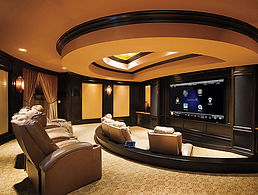
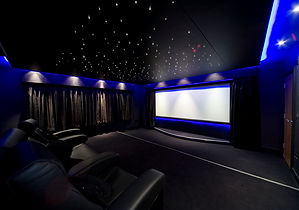
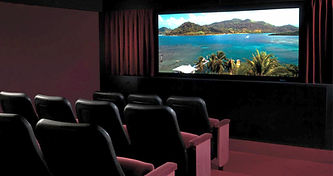

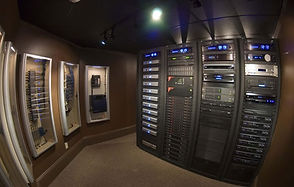
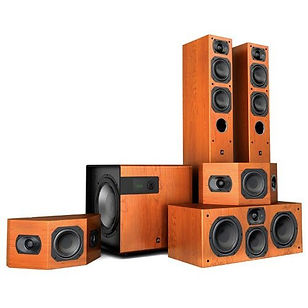



JVC Projector Review - Explaining e-shift2 Technology
Downloads











